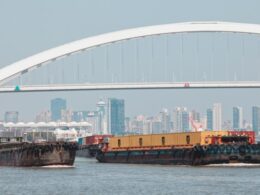In the aftermath of US President Donald Trump’s “liberation day” tariffs, consumer goods companies were divided over the severity of the impact. Some ripped up their financial forecasts, while others told analysts and investors in recent weeks they could weather the storm.
However, companies producing everything from PlayStation consoles to mayonnaise and laundry detergent for the western world largely agreed on one thing: Trump’s tariffs mean prices for consumers will have to rise.
But the problem for Procter & Gamble, Nestlé, Unilever and the other giants of the consumer goods industry is that after three years of hefty inflation, and with US consumer confidence at its lowest level since 2020, shoppers may not be willing to bear any more pain.
“The consumer is fatigued,” said Rob Holston, EY’s global consumer products lead. “They’re not just seeing the price of cornflakes go higher, it’s also their life has got more complex . . . the uncertainty of job losses, recession, and how long all this will last.”
After unveiling steep tariffs on US trading partners on April 2, Trump subsequently announced a 90-day pause to allow room for new trade deals to be thrashed out. A baseline 10 per cent tariff on the majority of imports remains in place, apart from those from China, which are subject to a prohibitive 145 per cent tariff.
As a result, companies ranging from Adidas to luxury group Hermés and Sony have all warned that US consumers will be paying higher prices.
Seven major luxury brands raised prices around the world in April, according to analysts at Citi. Dior and Louis Vuitton, both owned by LVMH, increased prices by 4 and 5 per cent respectively on a selection of products tracked by the bank, while Richemont-owned jeweller Van Cleef & Arpels increased prices by 5 per cent on nearly its entire range.
Producers of household goods — including Colgate-Palmolive, Nestlé and Unilever — have also indicated they will raise their prices to offset the impact of tariffs.
Rich Shepherd, an analyst at Mintel, said price rises would probably be steeper for US consumers than those in other countries.

“What people have had to cope with is really difficult in terms of price rises,” said Shepherd, who added consumers have become accustomed to a “constant swirl of uncertainty”.
“There may come a point where . . . people reach a breaking point [on price rises], but at the minute, at least, this is kind of just the next thing [they have] to think about,” he said.
Consumer goods companies are locked in negotiations with retailers on both sides of the Atlantic, and there are signs that winning their support for price rises is proving difficult.
One executive at a major UK supermarket said he “was calling bullshit” on companies trying to push through price increases under the cover of tariffs. Trump’s pause on most tariffs means the only large increase in duties, for now at least, is on shipments between the US and China.
“You can source virtually every ingredient from countries outside of the US, apart from maybe walnuts,” the executive said. “Suppliers are pushing for price rises and we’re saying to them: ‘Look, you’ve got to be careful here, otherwise you’re going to kill the golden goose.’ Consumers can’t take much more of this.”

Tensions were high between supermarkets and suppliers even before Trump’s tariffs. Heineken chief financial officer Harold van den Broek told analysts last month that some European supermarkets were even demanding price reductions from them, partly because the increases of the past few years were sapping consumer demand for beer.
“We are in tough negotiations because we don’t believe [price cuts] are fully warranted,” said van den Broek.
There are few signs of consumer demand improving, either. WK Kellogg, the US breakfast cereal producer, this week reported sales volumes fell 8.6 per cent in the first quarter, as it raised prices by 3 per cent.
The foam shoe company Crocs pulled financial guidance on Thursday, citing the “potential for softer consumer demand” because of tariffs. “We do expect the industry to go up in terms of price,” chief executive Andrew Rees told analysts.
Top US retailer Walmart, which is planning to hold down prices on some products to win market share, is due to report earnings next week.

Michael Waterson, professor of economics at Warwick University, said that multinationals with broad product ranges, like Unilever or Nestlé, have “significant latitude” as to where they pass on any increase in costs.
He added that one of the key factors driving that decision would probably be the extent to which demand weakens when prices rise across a company’s product portfolio.
“It makes economic sense to load price rises more on to areas where demand will reduce less,” Waterson said.
According to EY’s annual consumer survey of 20,000 people across 26 countries, which was published in March, shoppers said they were most likely to reduce spending on snacks and confectionery, alcohol, dining out and takeaway food. They were less likely to cut down on purchases of fresh food, household care products, clothing and footwear.
Claus Niegsch, an analyst at DZ Bank, said that while many consumer goods were likely to become more expensive in the US, that may not be the case in Europe.
Niegsch said goods that were originally intended for the US market would be diverted to other markets at knockdown prices to avoid tariffs — limiting the ability of companies in those markets to raise prices.
In April, the first month since Trump kicked off his latest trade war, Chinese exports to the US fell 21 per cent compared with last year. Exports to Europe rose 8 per cent.
Niegsch said: “The concern about rising import prices may be premature.”
Additional reporting by Gregory Meyer in New York and Florian Müller in Frankfurt
Source link









